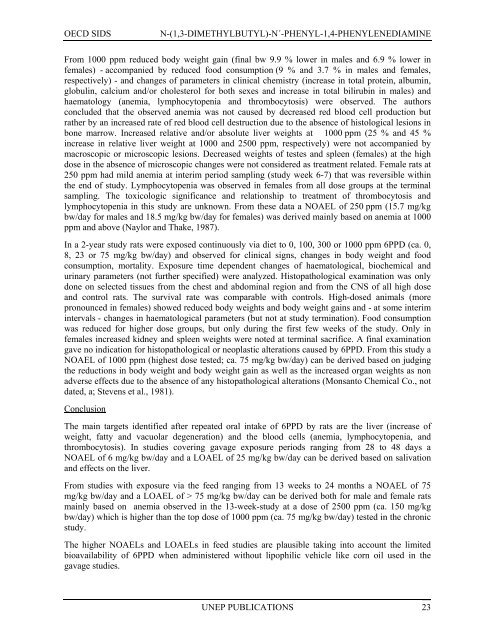N-(1,3-Dimethylbutyl)-N
N-(1,3-Dimethylbutyl)-N
N-(1,3-Dimethylbutyl)-N
You also want an ePaper? Increase the reach of your titles
YUMPU automatically turns print PDFs into web optimized ePapers that Google loves.
OECD SIDS<br />
N-(1,3-DIMETHYLBUTYL)-N´-PHENYL-1,4-PHENYLENEDIAMINE<br />
From 1000 ppm reduced body weight gain (final bw 9.9 % lower in males and 6.9 % lower in<br />
females) - accompanied by reduced food consumption (9 % and 3.7 % in males and females,<br />
respectively) - and changes of parameters in clinical chemistry (increase in total protein, albumin,<br />
globulin, calcium and/or cholesterol for both sexes and increase in total bilirubin in males) and<br />
haematology (anemia, lymphocytopenia and thrombocytosis) were observed. The authors<br />
concluded that the observed anemia was not caused by decreased red blood cell production but<br />
rather by an increased rate of red blood cell destruction due to the absence of histological lesions in<br />
bone marrow. Increased relative and/or absolute liver weights at 1000 ppm (25 % and 45 %<br />
increase in relative liver weight at 1000 and 2500 ppm, respectively) were not accompanied by<br />
macroscopic or microscopic lesions. Decreased weights of testes and spleen (females) at the high<br />
dose in the absence of microscopic changes were not considered as treatment related. Female rats at<br />
250 ppm had mild anemia at interim period sampling (study week 6-7) that was reversible within<br />
the end of study. Lymphocytopenia was observed in females from all dose groups at the terminal<br />
sampling. The toxicologic significance and relationship to treatment of thrombocytosis and<br />
lymphocytopenia in this study are unknown. From these data a NOAEL of 250 ppm (15.7 mg/kg<br />
bw/day for males and 18.5 mg/kg bw/day for females) was derived mainly based on anemia at 1000<br />
ppm and above (Naylor and Thake, 1987).<br />
In a 2-year study rats were exposed continuously via diet to 0, 100, 300 or 1000 ppm 6PPD (ca. 0,<br />
8, 23 or 75 mg/kg bw/day) and observed for clinical signs, changes in body weight and food<br />
consumption, mortality. Exposure time dependent changes of haematological, biochemical and<br />
urinary parameters (not further specified) were analyzed. Histopathological examination was only<br />
done on selected tissues from the chest and abdominal region and from the CNS of all high dose<br />
and control rats. The survival rate was comparable with controls. High-dosed animals (more<br />
pronounced in females) showed reduced body weights and body weight gains and - at some interim<br />
intervals - changes in haematological parameters (but not at study termination). Food consumption<br />
was reduced for higher dose groups, but only during the first few weeks of the study. Only in<br />
females increased kidney and spleen weights were noted at terminal sacrifice. A final examination<br />
gave no indication for histopathological or neoplastic alterations caused by 6PPD. From this study a<br />
NOAEL of 1000 ppm (highest dose tested; ca. 75 mg/kg bw/day) can be derived based on judging<br />
the reductions in body weight and body weight gain as well as the increased organ weights as non<br />
adverse effects due to the absence of any histopathological alterations (Monsanto Chemical Co., not<br />
dated, a; Stevens et al., 1981).<br />
Conclusion<br />
The main targets identified after repeated oral intake of 6PPD by rats are the liver (increase of<br />
weight, fatty and vacuolar degeneration) and the blood cells (anemia, lymphocytopenia, and<br />
thrombocytosis). In studies covering gavage exposure periods ranging from 28 to 48 days a<br />
NOAEL of 6 mg/kg bw/day and a LOAEL of 25 mg/kg bw/day can be derived based on salivation<br />
and effects on the liver.<br />
From studies with exposure via the feed ranging from 13 weeks to 24 months a NOAEL of 75<br />
mg/kg bw/day and a LOAEL of > 75 mg/kg bw/day can be derived both for male and female rats<br />
mainly based on anemia observed in the 13-week-study at a dose of 2500 ppm (ca. 150 mg/kg<br />
bw/day) which is higher than the top dose of 1000 ppm (ca. 75 mg/kg bw/day) tested in the chronic<br />
study.<br />
The higher NOAELs and LOAELs in feed studies are plausible taking into account the limited<br />
bioavailability of 6PPD when administered without lipophilic vehicle like corn oil used in the<br />
gavage studies.<br />
UNEP PUBLICATIONS 23
















